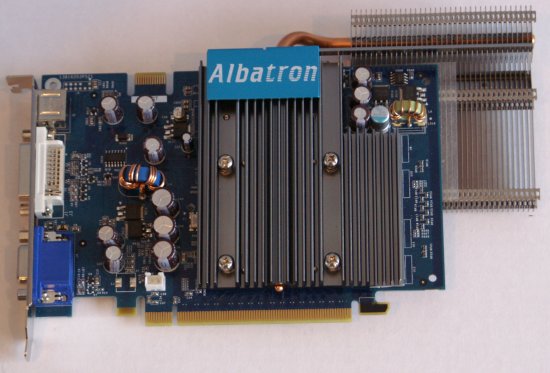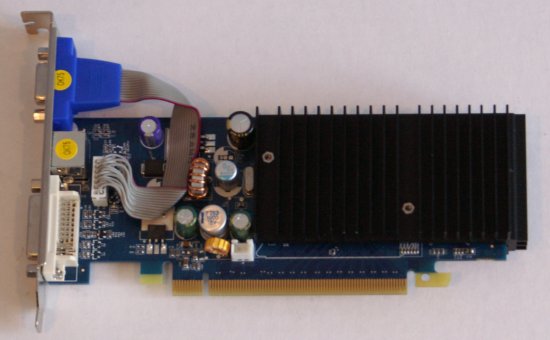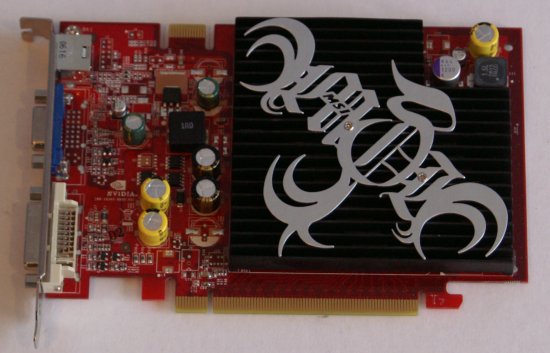Albatron

We also have a single card from Albatron, the Albatron NVIDIA GeForce 7300 GT. This card comes with a core clock of 400MHz, 50MHz higher than stock, and an 800MHz memory clock, like the Gigabyte 7300 GT.

The Albatron 7300 GT almost looks as though the design was inspired partly by the silent ASUS 7800 GT and 6600 GT. The face of the card has a metal heat sink with vertical ridges on it, and extending from the top of the card is an arm with lots of added metal plates that at first glance looks like it might be able to swing out ASUS style. The arm is fixed in place however, and the extra bit of heat sink adds about an inch an a half to the length of the card. The metal plates on the extended part of the heat sink are very thin and because they stick out a good bit from the rest of the card they can be damaged easily.
Sparkle

Sparkle provided us with a card that is somewhat unique compared to our other silent solutions in this review. We have a single Sparkle card, the NVIDIA GeForce 7300 GS Ultra 2, and it happens to be the smallest card of the group. The 7300 GS Ultra 2 looks almost as if someone took a notebook NVIDIA 7200 card and put a desktop style heat sink on it that wraps from the front around to the back. Interestingly, the Sparkle 7300 GS Ultra 2 is clocked lower than the other 7300 GS cards, with a core clock of 550 MHz, and a memory clock of 532 MHz. The combination of the 7300 GS chipset with slower memory proves to be one of the slowest in the group, although for tasks that don't require a lot from the GPU it will still work. It's also capable of functioning as a half-height card if you remove the VGA connection and replace the rear mounting bracket.

MSI

Lastly, we have two cards from MSI, the NVIDIA GeForce NX7600 GS, and the NVIDIA GeForce NX7300 GT. The two cards have a similar heat sink design, with the MSI logo in flamboyant gothic chrome lettering on top of a black heat sink.


Both MSI cards are clocked at reference speeds, 400MHz and 800/MHz for the 7600 GS, and 350MHz and 667MHz for the 7300 GT. We aren't sure if the Gothic lettering on the heat sinks adds in some way to the cooling of the card, but there isn't much doubt that these cards have the most artistic logo on them out of the rest in our review. The two cards appear virtually identical, with the exception of display connections: the 7300 GT has one DVI and one VGA port while the 7600 GS offers two DVI ports.

We also have a single card from Albatron, the Albatron NVIDIA GeForce 7300 GT. This card comes with a core clock of 400MHz, 50MHz higher than stock, and an 800MHz memory clock, like the Gigabyte 7300 GT.

The Albatron 7300 GT almost looks as though the design was inspired partly by the silent ASUS 7800 GT and 6600 GT. The face of the card has a metal heat sink with vertical ridges on it, and extending from the top of the card is an arm with lots of added metal plates that at first glance looks like it might be able to swing out ASUS style. The arm is fixed in place however, and the extra bit of heat sink adds about an inch an a half to the length of the card. The metal plates on the extended part of the heat sink are very thin and because they stick out a good bit from the rest of the card they can be damaged easily.
Sparkle

Sparkle provided us with a card that is somewhat unique compared to our other silent solutions in this review. We have a single Sparkle card, the NVIDIA GeForce 7300 GS Ultra 2, and it happens to be the smallest card of the group. The 7300 GS Ultra 2 looks almost as if someone took a notebook NVIDIA 7200 card and put a desktop style heat sink on it that wraps from the front around to the back. Interestingly, the Sparkle 7300 GS Ultra 2 is clocked lower than the other 7300 GS cards, with a core clock of 550 MHz, and a memory clock of 532 MHz. The combination of the 7300 GS chipset with slower memory proves to be one of the slowest in the group, although for tasks that don't require a lot from the GPU it will still work. It's also capable of functioning as a half-height card if you remove the VGA connection and replace the rear mounting bracket.

MSI

Lastly, we have two cards from MSI, the NVIDIA GeForce NX7600 GS, and the NVIDIA GeForce NX7300 GT. The two cards have a similar heat sink design, with the MSI logo in flamboyant gothic chrome lettering on top of a black heat sink.


Both MSI cards are clocked at reference speeds, 400MHz and 800/MHz for the 7600 GS, and 350MHz and 667MHz for the 7300 GT. We aren't sure if the Gothic lettering on the heat sinks adds in some way to the cooling of the card, but there isn't much doubt that these cards have the most artistic logo on them out of the rest in our review. The two cards appear virtually identical, with the exception of display connections: the 7300 GT has one DVI and one VGA port while the 7600 GS offers two DVI ports.










49 Comments
View All Comments
TheInternal - Tuesday, September 12, 2006 - link
It's wonderful to see Anandtech take the time to review silent products. I've really been trying to quiet down my PC, and seeing this review gave me some further encouragement. With rumors of ASUS acquiring XFX, it will be interesting to see if Anandtech decides to review the passively colled XFX 7950 GT with heat pipes that look awfully reminescent of the ones from the ASUS 7800 you reviewed.I'm also curious to see if any 7900 GS cards become available with passive cooling soon.
Richey02hg - Tuesday, September 5, 2006 - link
I was just curious if any of these cards are AGP? or they all PCI Express only? and also, its hard to tell since an x800xt all in one wonder isnt in there. But would any of these be an upgrade over that? Because I have to admit, just seeing that word "silent" makes me happy cause my GPU is insanely loudJarredWalton - Wednesday, September 6, 2006 - link
All are PCIe. I'm not sure if there are any silent AGP cards out there other than very low end components. As for the X800 XT, that is roughly equivalent to the 7800 GS in performance, albeit without SM 3.0 support. 7600 GT would also be pretty similar in performance I think. I would recommend holding onto your current system as long as you can, and when he can no longer stand the performance it offers do a wholesale upgrade to PCI-E GPU and motherboard, and probably a new CPU and RAM is well. At that point, you might as well just go ahead and buy a completely new system -- you could even try selling off your current system to recoup some of the cost.Richey02hg - Thursday, September 7, 2006 - link
thanks for the advice, Im actually planning to get a laptop in 2006 and thanks to your review im definetly waiting for that second wave (forget the name) of the core 2 duos for laptops :)Eddie Lin - Thursday, August 31, 2006 - link
Gigabyte seems don't need reserve SLI bridge seems 7300GS only go with S/W SLI and don't need bridge. Is really good heatsink design on this cardDerekWilson - Friday, September 1, 2006 - link
Thanks Eddie --We have added this information to the article.
yacoub - Thursday, August 31, 2006 - link
It's an absolute joke that Asus and Gigabyte don't have silently-cooled 7900GTs out yet. The card requires less power and runs cooler than the 7800GT did. It's a shoe-in to get a silent version. wtf.This is practically a roundup of grandfathers and retirees when you include a 7800GT. ;P
nullpointerus - Friday, September 1, 2006 - link
Maybe they are trying to get rid of old cards without dropping the price too much?yyrkoon - Thursday, August 31, 2006 - link
Alot of people that would consider buying a fanless GPU wouldnt even care if it DID make tons of noise, some of us live in deserts, where its extremely dusty. There is nothing like owning an air compressor or two, just for 'dusting' you house, shops, and PC / electronics innards.I guess I'm one of the few people who actually enjoy having a fan or two on while I'm sleeping for background noise, but less moving parts means longer part life here in the Nevada desert. However, I own a eVGA 7600GT KO, that has a fan on it, and you know what, I have a really hard time hearing it from 6 feet away. In fact, the 120mm low RPM fans that came with my Lian Li case make more noise, and they dont make much noise themselves.
I think its a great idea that these manufactuers are making products like this, but at the same time, for me personally its not really an option. I only buy parts from a compnay with a good reputation, and offer excellent customer support, and hence I'm very picky about who I buy from. At the same time, I know what I want, and if something passive isnt availible on say a 7600GT (which is what I wanted for this current system), and at the same time, from a company I would normally buy parts from, then I wont bother. I would think it a better option to buy the part you wanted for a video card, then buy an aftermarket passive cooler if it comes down to that (which would probably void your warranty, so again, for some of us, not really an option).
So basicly, what it boils down to, is that I have to buy a graphics card with a fan to get what I want, and if problems later ensue, its a good thing I have a can of miracle oil around, and a few saringes . . .
Josh Venning - Thursday, August 31, 2006 - link
These are some good points; it's true that with less moving parts you would theoretically see longer life and resistence to dust and dirt, something that could be a plus. And while it's true that a normal graphics card (with a fan on it) will be pretty hard to hear from a little ways away inside your computer case, the idea is that some people need that extra bit of silence for whatever reason, and every extra fan adds to the noise level on the system. For myself, when recording sound/music with a computer, getting things as quiet as possible is very important, so this is one case where eliminating even a couple of dbs is worth buying a silent gpu for. (especially if, like myself, your recording computer is one you also want to be able to play games on.)